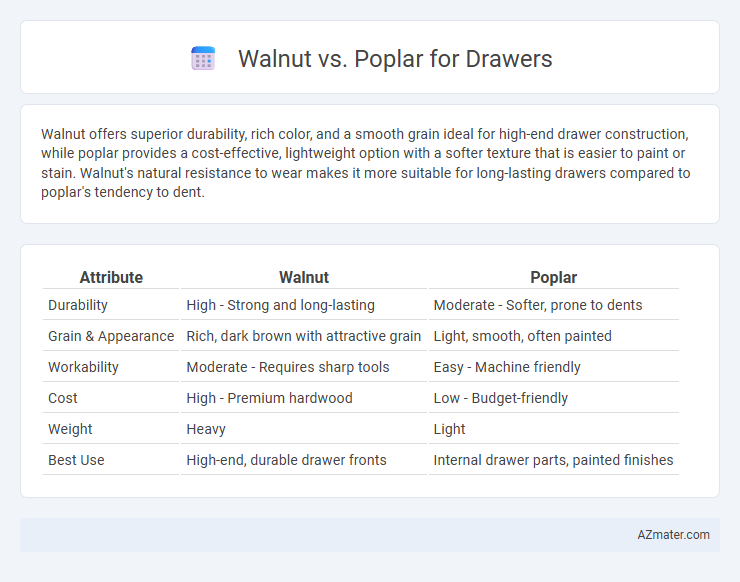Walnut offers superior durability, rich color, and a smooth grain ideal for high-end drawer construction, while poplar provides a cost-effective, lightweight option with a softer texture that is easier to paint or stain. Walnut's natural resistance to wear makes it more suitable for long-lasting drawers compared to poplar's tendency to dent.
Table of Comparison
| Attribute | Walnut | Poplar |
|---|---|---|
| Durability | High - Strong and long-lasting | Moderate - Softer, prone to dents |
| Grain & Appearance | Rich, dark brown with attractive grain | Light, smooth, often painted |
| Workability | Moderate - Requires sharp tools | Easy - Machine friendly |
| Cost | High - Premium hardwood | Low - Budget-friendly |
| Weight | Heavy | Light |
| Best Use | High-end, durable drawer fronts | Internal drawer parts, painted finishes |
Introduction: Walnut vs Poplar for Drawer Construction
Walnut offers a rich, dark grain and exceptional durability, making it a premium choice for drawer construction known for its strength and resistance to wear. Poplar is a lightweight, affordable hardwood with a fine, even texture that is easier to work with but less durable and prone to dents compared to walnut. Selecting between walnut and poplar depends on balancing aesthetic preference, budget constraints, and the desired longevity of the drawer furniture.
Wood Characteristics: Walnut and Poplar Compared
Walnut features a rich, dark brown grain with excellent durability and natural resistance to warping, making it ideal for high-quality drawers that require strength and visual appeal. Poplar, by contrast, is a lighter, softer hardwood with a pale color and more uniform grain, offering ease of machining but less durability and susceptibility to dents. Choosing between walnut and poplar depends on the desired balance between aesthetic richness, structural integrity, and cost-effectiveness for drawer construction.
Durability and Strength: Which Wood Lasts Longer?
Walnut offers superior durability and strength compared to poplar, making it a preferred choice for long-lasting drawers in high-use environments. With a Janka hardness rating of approximately 1,010, walnut resists dents and wear better than poplar, which has a lower hardness rating around 540. The dense grain structure of walnut enhances its longevity, while poplar's softer composition may lead to quicker degradation under heavy use.
Appearance and Aesthetics: Choosing the Right Look
Walnut features a rich, dark brown hue with striking grain patterns, offering a luxurious and elegant appearance for drawers, while poplar presents a lighter, creamy tone with subtle grain, suitable for painted finishes and modern designs. Walnut's natural variation and depth make it ideal for showcasing the wood's beauty in boutique or high-end furniture, whereas poplar's uniform texture and ease of staining provide versatility for customized aesthetics. Selecting between walnut and poplar hinges on whether a warm, sophisticated look or a smooth, adaptable surface aligns best with the desired drawer style.
Workability: Ease of Cutting and Shaping
Walnut offers excellent workability with its fine, straight grain and moderate hardness, allowing for smooth cutting and precise shaping in drawer construction. Poplar is softer and lighter, making it easier to cut, shape, and sand, especially for beginners or intricate designs. Both woods respond well to tools, but walnut provides a more durable finish, while poplar's softness reduces tool wear and speeds up the work process.
Cost Comparison: Walnut vs Poplar
Walnut generally costs between $8 and $15 per board foot, making it a premium wood option for drawers due to its rich color and durability. Poplar, in contrast, ranges from $2 to $5 per board foot, offering a budget-friendly alternative with softer texture and lighter color. Choosing between walnut and poplar for drawers hinges largely on balancing cost considerations with desired aesthetic and longevity.
Finishing Options and Versatility
Walnut offers a rich, dark finish that enhances the natural grain, allowing for smooth staining and polishing to achieve a luxurious appearance in drawers. Poplar, known for its light color and even texture, provides excellent versatility with paint-friendly surfaces, enabling a wide range of color options and finishes. Both woods accommodate various finishing techniques, but walnut excels in natural and oil finishes while poplar is preferred for painted applications and customizable drawer designs.
Weight Considerations for Drawer Use
Walnut, with a density of approximately 600 kg/m3, offers a sturdy yet moderately heavy option for drawers, ensuring durability without excessive weight. Poplar is significantly lighter, around 400 kg/m3, making it easier to handle and ideal for drawers where weight reduction is a priority. For heavy-use drawers, walnut provides superior strength, while poplar suits lightweight, less demanding applications.
Environmental Impact and Sustainability
Walnut wood, sourced from slow-growing hardwood trees, often involves long-term forest management practices that can support sustainability but may have higher environmental costs due to longer growth cycles and limited availability. Poplar, a fast-growing hardwood species, offers a more sustainable option for drawers by enabling quicker regeneration, lower carbon footprint, and reduced deforestation pressures. Both woods require responsible sourcing certifications like FSC to ensure minimal environmental impact and promote sustainable forestry.
Best Applications: When to Choose Walnut or Poplar for Drawers
Walnut is ideal for high-end drawers requiring durability and rich, dark aesthetics, making it perfect for luxury furniture and heirloom pieces. Poplar is best suited for painted drawers or projects prioritizing budget and ease of workability due to its fine grain and affordability. Choose walnut for visible, premium finish and longevity, while poplar is excellent for cost-effective, customizable drawer components.

Infographic: Walnut vs Poplar for Drawer
 azmater.com
azmater.com